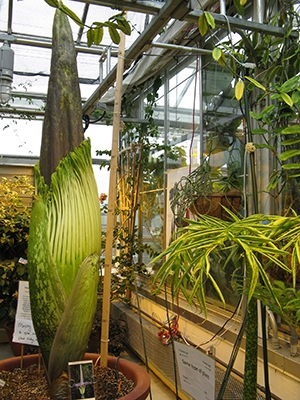UPDATED: September 21, 2016
The Life Sciences Greenhouse at Dartmouth, which opened in 2011, is home to an extensive and varied plant collection, including an Amorphophallus titanum, known as the titan arum or a corpse flower— a flowering plant with the largest unbranched inflorescence in the world that is native to western Sumatra.
The Life Sciences Greenhouse may be the only place in northern New England that has a titan arum. Dartmouth’s titan arum is named Morphy and is 13 years old. Morphy is expected to bloom this weekend, a rare opportunity given that “in the U.S. alone this summer, there have only been seven flowers that have bloomed” according to ScienceAlert. The greenhouse is open to the public year-round and will have extended hours for viewing.
The titan arum can grow to over 10 feet tall and is known for its impressive height and striking color, which is deep green on the outside and dark burgundy on the inside. It is known as the corpse flower due to its pungent odor, which has been compared to the smell of a decaying animal. The smell attracts carrion beetles and flesh flies that serve as natural pollinators, which typically feed on and lay their eggs in decaying material.
Image  |
Morphy, the titan arum or corpse flower, getting ready to bloom at the Life Sciences Greenhouse at Dartmouth. (Photo taken on 9/19/16 by Eli Burakian ’00) |
Morphy was seeded in 2003 by a private grower in New Hampshire and was acquired by Dartmouth in 2007. This type of plant will not flower until the tuber is about seven or eight years old. Each year, a titan arum sends up either a leaf or a flower; each leaf lives for almost a year, whereas, a flower lives less than a week. Morphy bloomed once before in July 2011. Since then, it has grown a leaf on two separate occasions during which the leaves were photosynthesizing and storing energy before it sent up the current flower. The flowers must have enough stored energy to send up a flower. This past July, the Life Sciences Greenhouse repotted Morphy’s tuber, which had an estimated weight of 37 to 39 pounds. More information about the life cycle of the titan arum can be found in a diagram by the Chicago Botanic Garden.
The Life Sciences Greenhouse estimates that Morphy will bloom this weekend. The flower will only be open for about two to three days total. Once the flower opens, its odor will be the strongest for only a day or so. It will die several days after it blooms. The flower is currently 7 feet tall and may grow more before it opens next week. You can see Morphy on the greenhouse’s live webcam at: https://www.dartmouth.eduhttps://www.dartmouth.edu/~grnhouse/
The Life Sciences Greenhouse at Dartmouth is also home to the Brout Orchid Collection, which houses about a thousand orchids of many species and hybrids in two rooms. There are three other rooms open to the public: a tropical room, a sub-tropical room, and a xeric room housing cacti and succulents.
Media interested in visiting the greenhouse to cover Morphy, the corpse flower, should contact Amy Olson at: amy.d.olson@dartmouth.edu.
Visitor Information
Please visit the Life Sciences Greenhouse at Dartmouth website for visitor information, including extended hours.
Parking
Visitors can park in Dewey parking lot on the north side of the Life Sciences Building. The Dewey parking lot is located at the corner of Lyme Road (Route 10) and North Park Street (Route 120).

